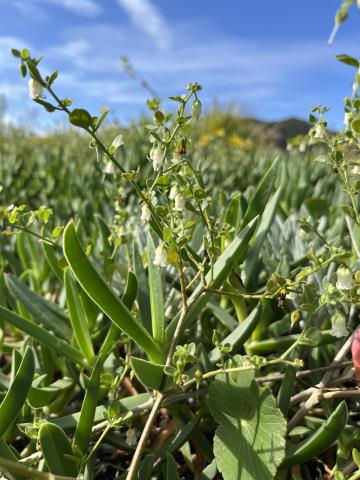Published On
11/04/2024As we all start to get back in the rhythm of the year, and spend more time outdoors on site, it is important to note that new weed incursions have been identified on the Central Coast. As always with new weeds, there is a possibility these have, or will, make their way into our EVP sites. Because of this Ivan Pillay, Council’s Biosecurity Officer (Weeds), has alerted us to the discovery of a new invasive weed species (Pampas Lily) that was recently discovered on the Central Coast. Ivan has also provided an update on the spread of Salvinia into a new creek system at Wyong.
It’s always important to keep a look out for any new or suspicious looking plants on your sites, and when you are out and about enjoying the Central Coast.
Pampas Lily of the Valley
Pampas Lily of the Valley (Salpichroa origanifolia), is a plant native to South America. It grows in warm temperate climates, often semi-arid regions and is usually found in sandy, alkaline soils. This weed has now been detected at Ettalong Beach and is currently covering an area of 150m2. At the moment, this is the only known location of this weed on the Central Coast.
Pampas Lily has become a serious issue in other parts of Australia. It smothers native shrubs, small plants, and grasses where it becomes established, and the much-needed structure of the native vegetation for stabilising dunes can be lost. Eradicating this weed is a high priority for Central Coast Council.
Council has engaged professional bush regenerators to carry out works in an effort to eradicate Pampas Lily from the site, and therefore from the Central Coast. The infested area will be sprayed with a herbicide which has been chosen for it’s effectiveness against the weed whilst also having a very low toxicity to mammals, birds, fish and insects. Through an intensive eradication effort with early and swift actions it is hoped that the weed will not spread from the current infestation site. Early actions will also help preserve the native plants at the site and help maintain the stability of the dune system where the Pampas Lily is located.

Salvinia outbreak at Wyong
An outbreak of Salvinia (Salvinia molesta) has recently been detected at Wyong.
Salvinia is a perennial plant that is very adaptable and survives in many climates and nutrient levels. It grows best in warm fresh water that is still or slow-flowing and has high nutrient levels.
It can double in size in less than 3 days in ideal conditions. Rain can also stimulate growth by washing nutrients into the water.
Salvinia can survive:
- low temperatures and occasional frosts if there is a thick mat to protect some plants (exposed parts of the plant will be killed by frost)
- brackish water although sea water will kill it
- dry periods, as the thick mat can protect the buds.
Our Biosecurity Weeds Officer, along with our Catchment Management team, have been conducting inspections both on upstream and riparian zones and will also be working with landowners to help manage the infestation at Wyong.
What to do if you spot Pampas Lily or Salvinia?
Our volunteers are invaluable in the protection and preservation of our natural environment and your support is greatly appreciated. If you identify these weeds on your site, or at any location on the Central Coast, please report them to Council's Biosecurity Weeds Officer, Ivan Pillay by email at Ivan.pillay@centralcoast.nsw.gov.au.
All weed data collected is recorded on the Biosecurity Information System (BIS) Weeds and used by Department of Industries (DPI) to monitor compliance, extension, control and inspection activities.
Stay tuned for more weeds to watch.
This article was written by Ivan Pillay (Biosecurity Officer Weeds), and Carlita Dhillon (Environmental Education Officer), Central Coast Council.